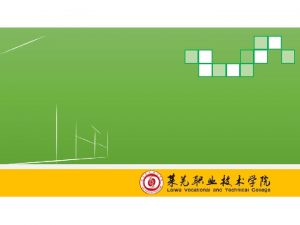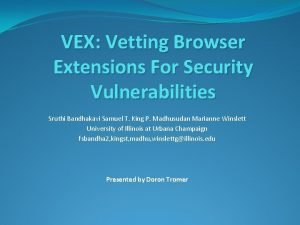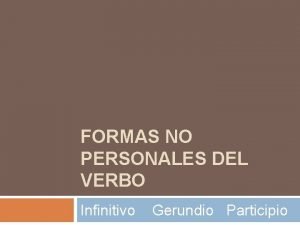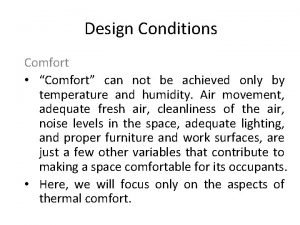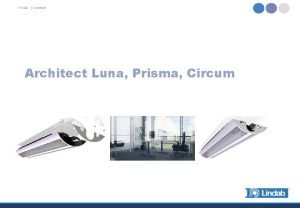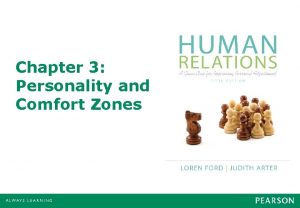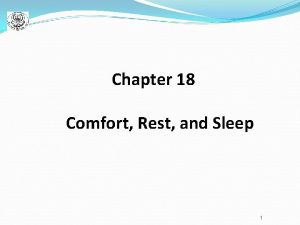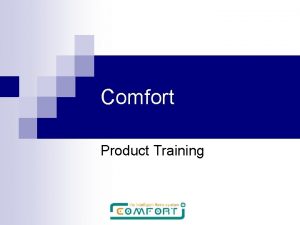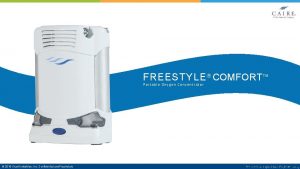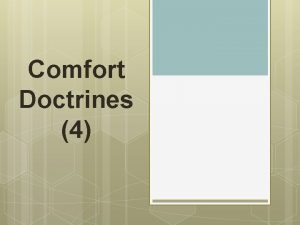Optimal Personal Comfort Management Using SPOT Peter Xiang







![[1] SPOT Clothing Sensing 5° infrared sensor: • Detects users’ clothing surface temperature Microsoft [1] SPOT Clothing Sensing 5° infrared sensor: • Detects users’ clothing surface temperature Microsoft](https://slidetodoc.com/presentation_image/4f11cf62dcbcdd5264bd58e9212c65c8/image-8.jpg)






















- Slides: 30

Optimal Personal Comfort Management Using SPOT+ Peter Xiang Gao, S. Keshav University of Waterloo

HVAC Energy use �Buildings use 1/3 of all energy � 30 -50% of building energy is for HVAC �Can save energy by changing temperature setpoint: � 1 o. C higher when cooling ≈ 10% saving � 1 o. C lower when heating ≈ 2 -3% saving

Focus of this work Consider a single office heating system in winter Assume �Thermal isolation �Personal thermal control (heater)

Personal Office Thermal Comfort Management Office Corridor Office

SPOT+: A Smart Personalized Office Thermal Control System Personal Thermal Comfort Evaluation Learning-Based Modeling Occupancy Arrive office Lunch Leave office 6 7 8 9 10 11 12 13 14 15 16 17 18 Time of a day Occupancy Prediction Temperature 500 W -> f ( • ) -> + 1 o. C 26. 5 24. 5 22. 5 20. 5 6 7 8 9 10 11 12 13 14 15 16 17 18 Time of a day Setpoint Scheduling

SPOT+: A Smart Personalized Office Thermal Control System Personal Thermal Comfort Evaluation Learning-Based Modeling Occupancy Arrive office Lunch Leave office 6 7 8 9 10 11 12 13 14 15 16 17 18 Time of a day Occupancy Prediction Temperature 500 W -> f ( • ) -> + 1 o. C 26. 5 24. 5 22. 5 20. 5 6 7 8 9 10 11 12 13 14 15 16 17 18 Time of a day Setpoint Scheduling

Predicted Mean Vote (PMV) model �Air Temperature, Background Radiation, Air Velocity, Humidity, Metabolic Rate, Clothing Level Cold Cool Slightly Cool Neutral Slightly Warm Hot -3 -2 -1 0 1 2 3 ASHRAE Scale
![1 SPOT Clothing Sensing 5 infrared sensor Detects users clothing surface temperature Microsoft [1] SPOT Clothing Sensing 5° infrared sensor: • Detects users’ clothing surface temperature Microsoft](https://slidetodoc.com/presentation_image/4f11cf62dcbcdd5264bd58e9212c65c8/image-8.jpg)
[1] SPOT Clothing Sensing 5° infrared sensor: • Detects users’ clothing surface temperature Microsoft Kinect: • • Detects occupancy Detects location of the user Weather. Duck: • Senses other environmental variables ________________ [1] P. X. Gao, S. Keshav, SPOT: A Smart Personalized Office Thermal Control System, e-Energy 2013

Clothing level estimation �Estimate clothing by measuring emitted infrared �More clothing => lower infrared reading Clo = k * (tclothing – tbackground) + b �tclothing is the infrared measured from clothes on human body �tbackground is the background infrared radiation �k and b are parameters to be estimated by regression

Personalization �PMV model represents the average �for a single office, only the occupant’s vote matters �Predicted Personal Vote (PPV) Model ppv = fppv (pmv) where fppv( • ) is a linear function

SPOT+: A Smart Personalized Office Thermal Control System Personal Thermal Comfort Evaluation Learning-Based Modeling Occupancy Arrive office Lunch Leave office 6 7 8 9 10 11 12 13 14 15 16 17 18 Time of a day Occupancy Prediction Temperature 500 W -> f ( • ) -> + 1 o. C 26. 5 24. 5 22. 5 20. 5 6 7 8 9 10 11 12 13 14 15 16 17 18 Time of a day Setpoint Scheduling

Learning-Based Model Predictive Control �We model thermal characteristics of a room using LBMPC �The model can predict future temperature = flbmpc (current temperature, heater power)

Learning-Based Model Predictive Control �

Learning-Based Model Predictive Control �

SPOT+: A Smart Personalized Office Thermal Control System Personal Thermal Comfort Evaluation Learning-Based Modeling Occupancy Arrive office Lunch Leave office 6 7 8 9 10 11 12 13 14 15 16 17 18 Time of a day Occupancy Prediction Temperature 500 W -> f ( • ) -> + 1 o. C 26. 5 24. 5 22. 5 20. 5 6 7 8 9 10 11 12 13 14 15 16 17 18 Time of a day Setpoint Scheduling

Occupancy Prediction �We predict occupancy using historical data. 0. 3 1 1 1. 3 0 Match Previous similar history Predict using matched records ________________ [1] James Scott et. al. , Pre. Heat: Controlling Home Heating With Occupancy Prediction, Ubi. Comp 2011

SPOT+: A Smart Personalized Office Thermal Control System Personal Thermal Comfort Evaluation Learning-Based Modeling Occupancy Arrive office Lunch Leave office 6 7 8 9 10 11 12 13 14 15 16 17 18 Time of a day Occupancy Prediction Temperature 500 W -> f ( • ) -> + 1 o. C 26. 5 24. 5 22. 5 20. 5 6 7 8 9 10 11 12 13 14 15 16 17 18 Time of a day Setpoint Scheduling

Optimal Control �We use the optimal control strategy to schedule the setpoint over a day. �The control objective is to reduce energy consumption and still maintain thermal comfort Overall energy consumption in the optimization horizon S Weight of comfort, set to large value to guarantee comfort first Predicted occupancy, we only guarantee comfort when occupied. aka m(s) = 1 Thermal comfort penalty. Both term equal zero when the user feels comfortable

Optimal Control - Constraints �ε is the tolerance of predicted personal vote (PPV) �So when | ppv(x(s)) | is smaller than ε, there is no penalty �Otherwise, either βc(s) or βh(s) will be positive to penalize the discomfort thermal environment

Evaluation

Evaluation of clothing level estimation �Root mean square error (RMSE) = 0. 0918 �Linear correlation = 0. 9201

Predicted Personal Vote Estimation �Root mean square error (RMSE) = 0. 5377 �Linear correlation = 0. 8182

Accuracy of LBMPC �The RMSE over a day is 0. 17 C.

Accuracy of Occupancy Prediction �The result of optimal prediction is affected by occupancy prediction. �False negative 10. 4% (From 6 am. to 8 pm. ) �False positive 8. 0% (From 6 am. to 8 pm. ) �Still an open problem

Comparison of schemes

Limitations �SPOT+ requires thermal Insulation for personal thermal control �Current SPOT+ costs about $1000 �PPV requires some initial calibration �State of window/door is not modelled in the current LBMPC �Accuracy of clothing level estimation is affected by �Accuracy of Kinect �Distance effect of the infrared sensor

Conclusion �We extended PMV model for personalized thermal control �We design and implement SPOT+ �We use LBMPC and optimal control for personalized thermal control �SPOT+ can accurately maintain personal comfort despite environmental fluctuations �allows a worker to balance personal comfort with energy use.


Relationship between PPV and Energy cost � Maintaining a PPV of 0 consumes about 6 k. Wh electricity daily. By setting the target PPV to -0. 5, we can save about 3 k. Wh electricity per day.

Average Discomfort vs Energy Consumption
 E e e poem
E e e poem Vex xiang
Vex xiang Cheng xiang zhai
Cheng xiang zhai Liu xiang weightlifter
Liu xiang weightlifter Cheng xiang zhai
Cheng xiang zhai Liu xiang
Liu xiang Xiang yu liu bang
Xiang yu liu bang Cheng xiang zhai
Cheng xiang zhai Its rosewhatt
Its rosewhatt Cheng xiang zhai
Cheng xiang zhai Cheng zhai
Cheng zhai Xiang yang liu
Xiang yang liu Routing table
Routing table Rest publish subscribe
Rest publish subscribe Music producer job description
Music producer job description Xiang jiao ping guo
Xiang jiao ping guo Cheng xiang zhai
Cheng xiang zhai Perfume xia xiang
Perfume xia xiang Vex xiang
Vex xiang Xiang cheng mit
Xiang cheng mit Yongqing xiang
Yongqing xiang Pain management fundamentals of nursing
Pain management fundamentals of nursing Pensamiento sistemico peter senge
Pensamiento sistemico peter senge The korean american artist hyo in kim created
The korean american artist hyo in kim created Formas del verbo no personales
Formas del verbo no personales Adivinanzas sobre higiene personal
Adivinanzas sobre higiene personal Halimbawa ng personal na misyon sa buhay
Halimbawa ng personal na misyon sa buhay Shop safety color coding system
Shop safety color coding system Example paragraph using personal pronouns
Example paragraph using personal pronouns Droplet precautions ppe
Droplet precautions ppe Using system.collections
Using system.collections








